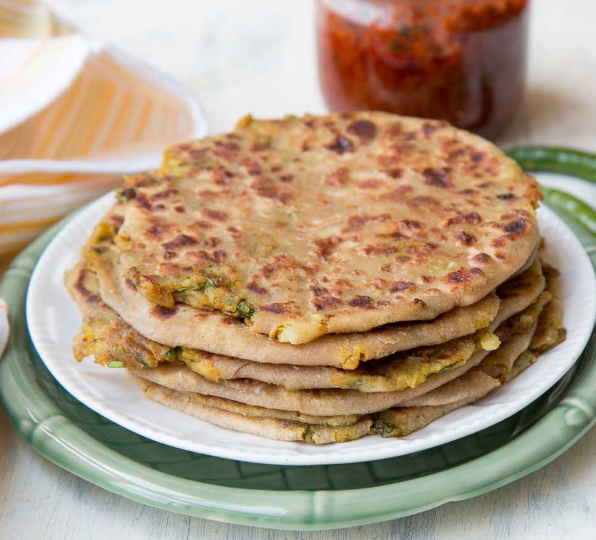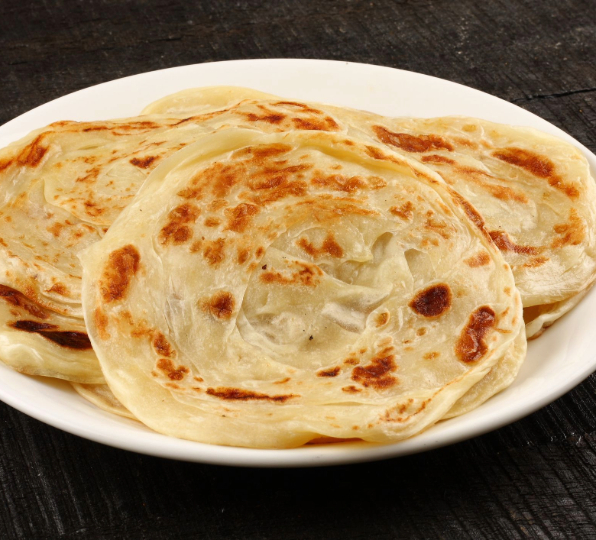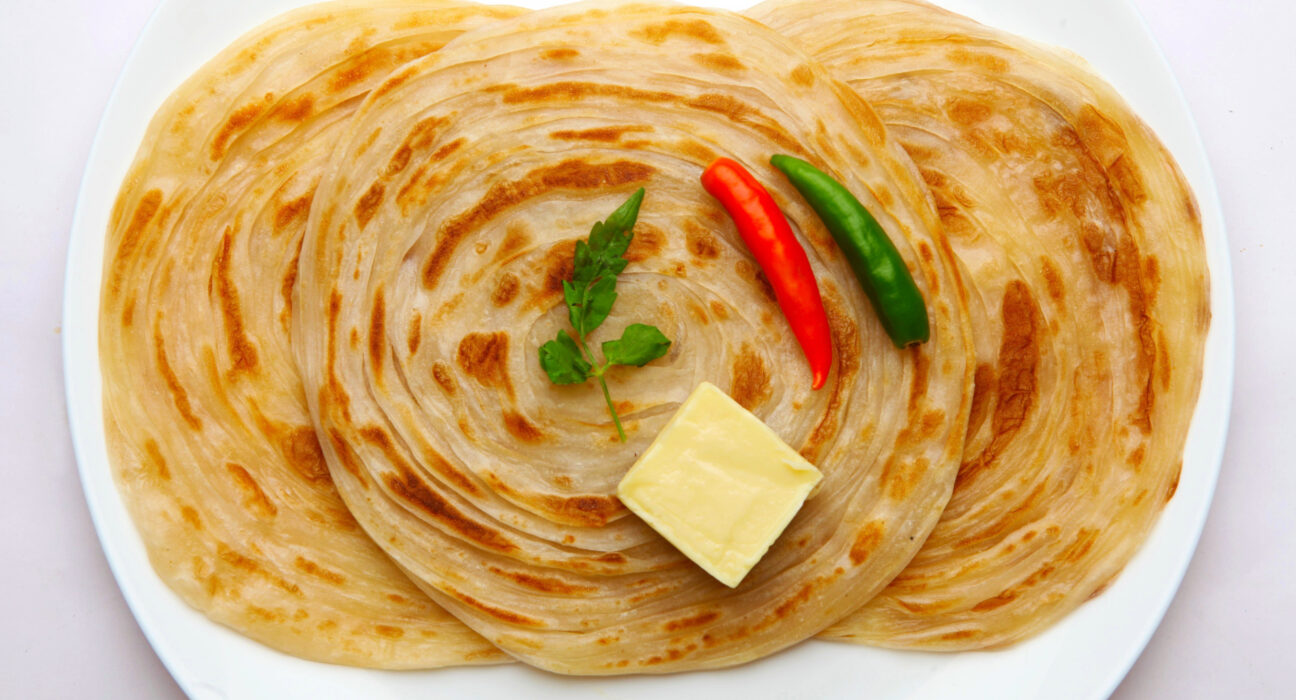Introduction:
Many homes love to serve paratha for breakfast. It’s a common Indian flatbread made from whole wheat flour that’s frequently stuffed with different fillings like vegetables, paneer, or potatoes. Despite its obvious deliciousness, there are often concerns about its nutritional content and suitability as a breakfast food. In this blog, we’ll examine the question of whether paratha is a healthy breakfast option, gathering opinions from nutrition specialists and weighing the benefits and drawbacks of incorporating it into your daily schedule.
1. Nutritional Composition of Paratha
Paratha, a popular Indian flatbread, is not only a delicious and versatile dish but also offers a range of nutritional benefits. Its primary component, whole wheat flour, forms the base of the dough and provides a wealth of essential nutrients. Whole wheat flour is rich in complex carbohydrates, which serve as a significant energy source for the body. Additionally, it contains dietary fiber, which aids in digestion, promotes bowel regularity, and helps maintain a feeling of fullness, making paratha a satisfying option for meals.
In addition to carbohydrates and fiber, whole wheat flour also contributes protein to the diet. Protein is essential for muscle repair and growth, as well as for maintaining overall health. Moreover, whole wheat flour contains various vitamins and minerals, including B vitamins like niacin, thiamine, and folate, as well as minerals like iron, magnesium, and phosphorus, which play crucial roles in various bodily functions, such as energy metabolism, red blood cell production, and bone health.
The nutritional profile of paratha can be further enhanced depending on the fillings used. Common fillings include vegetables like potatoes, cauliflower, spinach, or fenugreek leaves, as well as paneer (Indian cottage cheese). These ingredients not only add flavor and texture to the paratha but also contribute additional nutrients to the dish. Vegetables are excellent sources of vitamins A and C, as well as minerals like potassium and calcium. Paneer, on the other hand, provides protein and calcium, which are essential for bone health and muscle function.
However, it’s essential to be mindful of the cooking method when preparing parathas. Traditional recipes often call for cooking the parathas in oil or ghee (clarified butter), which adds significant amounts of fat and calories to the dish. While fat is an essential nutrient and provides flavor and texture to the paratha, excessive consumption of fried foods can contribute to weight gain and other health issues, such as heart disease and high cholesterol levels. Therefore, it’s advisable to use moderation when cooking parathas and opt for healthier cooking methods, such as grilling or baking, whenever possible.
2. Expert Opinions
Gathering insights from nutritionists, dietitians, and health experts regarding the healthiness of paratha as a breakfast option can provide valuable perspectives on its nutritional value and potential drawbacks.
Those in favor of paratha may highlight its use of whole wheat flour, which provides complex carbohydrates, fiber, and essential nutrients. Whole grains offer sustained energy release and promote satiety, making paratha a filling breakfast choice. Additionally, the incorporation of vegetables or paneer as fillings adds vitamins, minerals, and protein to the meal, further enhancing its nutritional profile. For individuals with active lifestyles or those who require substantial energy in the morning, a well-balanced paratha can serve as a satisfying breakfast option.
However, experts may also caution against certain aspects of paratha consumption. While whole wheat flour is nutritious, the use of oil or ghee in cooking can significantly increase the calorie and fat content of parathas. Excessive consumption of fried foods may contribute to weight gain and adverse health effects, such as elevated cholesterol levels and increased risk of heart disease. Therefore, experts may recommend moderation when consuming parathas and advise choosing healthier cooking methods, such as baking or grilling, to reduce fat intake.
Moreover, the portion size of parathas should be considered, as oversized servings can lead to excessive calorie consumption. Pairing parathas with nutritious accompaniments, such as yogurt, fresh vegetables, or a side of protein, can help balance the meal and provide additional nutrients.
3. Pros of Eating Paratha for Breakfast
Eating paratha for breakfast offers several advantages that make it a popular choice among many individuals, especially in South Asian cuisine. Here are some of the pros of including paratha in your morning meal:
- Hearty and Satisfying: Parathas are known for their delicious taste and filling nature. The combination of whole wheat flour and savory fillings creates a substantial meal that can keep you feeling satisfied throughout the morning. This can be particularly beneficial for individuals with busy schedules who require a substantial breakfast to fuel their day.
- Nutrient-Rich: Parathas are typically made with whole wheat flour, which provides complex carbohydrates, fiber, protein, vitamins, and minerals. Whole wheat flour is a good source of nutrients such as B vitamins, iron, and magnesium, which are essential for overall health and well-being. Additionally, if the paratha is filled with vegetables or paneer, it can further enhance its nutritional value by adding vitamins, minerals, and additional fiber.
- Energy Boost: The complex carbohydrates in whole wheat flour provide a steady release of energy, helping to keep you energized and focused throughout the morning. This can be particularly beneficial for individuals who engage in physical activity or have demanding tasks ahead of them during the day.
- Versatile: Parathas can be customized to suit individual preferences and dietary needs. Whether you prefer a plain paratha or one filled with vegetables, paneer, or other ingredients, there are endless possibilities to explore. Additionally, parathas can be enjoyed with a variety of accompaniments such as yogurt, chutney, pickles, or fresh fruits, allowing for a diverse and flavorful breakfast experience.
- Cultural Significance: Parathas hold cultural significance in many regions, particularly in South Asian cuisine. Enjoying parathas for breakfast can be a way to connect with cultural heritage and traditions, making it a meaningful and enjoyable meal choice for many individuals.
Overall, parathas offer a combination of taste, nutrition, and versatility that makes them a popular and satisfying breakfast option for people around the world. When enjoyed as part of a balanced diet, parathas can contribute to a nutritious and fulfilling start to the day.
4. Cons of Eating Paratha for Breakfast
While parathas offer a delicious and satisfying breakfast option, there are certain considerations to keep in mind regarding their nutritional content and potential impact on health. Here are some cons of eating paratha for breakfast:
- High in Calories: Parathas are often cooked in oil or ghee, which significantly increases their calorie content. The added fats contribute to the richness and flavor of the paratha but also add extra calories. For individuals who are trying to manage their weight or calorie intake, consuming calorie-dense foods like parathas regularly may pose challenges.
- High in Saturated Fats: Oil or ghee used in the preparation of parathas are sources of saturated fats, which are known to increase LDL (bad) cholesterol levels and contribute to heart disease risk when consumed in excess. Regular consumption of parathas cooked in saturated fats may not be ideal for individuals with heart health concerns or those aiming to reduce their saturated fat intake.
- Potential for Overconsumption: Due to their tasty and filling nature, it’s easy to overeat parathas, especially when they are served with calorie-rich accompaniments such as fried potatoes, high-fat gravies, or sugary beverages. Overconsumption of calories can lead to weight gain over time, particularly if portion sizes are not controlled.
- Impact on Blood Sugar Levels: While whole wheat flour used in parathas provides complex carbohydrates, the addition of fats can affect how quickly these carbohydrates are digested and absorbed, potentially leading to rapid spikes in blood sugar levels. This may be a concern for individuals with diabetes or those trying to manage blood sugar levels.
- Lack of Variety: While parathas can be delicious and satisfying, relying solely on them for breakfast may result in a lack of dietary variety. A balanced breakfast should ideally include a variety of food groups to ensure adequate intake of essential nutrients.
5. Tips for Making Healthier Parathas
- Whole Wheat Flour: Opt for whole wheat flour instead of refined flour (maida) when making paratha dough. Whole wheat flour retains the bran and germ, providing more fiber, vitamins, and minerals compared to refined flour. This simple switch increases the nutritional value of parathas and promotes better digestion.
- Moderate Oil or Ghee: While oil or ghee adds flavor and prevents sticking during cooking, it’s essential to use them sparingly. Instead of generously slathering oil or ghee on the paratha dough, lightly brush the skillet or griddle with a small amount. This reduces the overall fat content while still achieving the desired texture and taste.
- Nutrient-Rich Fillings: Incorporate nutrient-rich fillings into your parathas to boost their nutritional content. Consider adding finely chopped vegetables like spinach, carrots, bell peppers, or grated cauliflower. You can also include protein-rich fillings such as paneer (cottage cheese), tofu, or lean meats like shredded chicken or turkey. These additions not only enhance the flavor but also increase the fiber, vitamins, and minerals in the parathas.
- Spice Blends: Experiment with homemade spice blends or masalas to add flavor to your parathas without relying solely on oil or ghee. Use a combination of aromatic spices like cumin, coriander, turmeric, and chili powder to season the dough or filling. Spices not only enhance taste but also offer various health benefits, including anti-inflammatory and antioxidant properties.
- Lighter Side Dishes: Instead of pairing parathas with calorie-rich accompaniments like fried potatoes or heavy gravies, opt for lighter side dishes. Serve parathas with fresh yogurt (curd), cucumber raita, mixed vegetable salads, or homemade chutneys made from fresh herbs and spices. These side dishes provide additional nutrients and hydration without adding excessive calories or fats.
- Incorporate Vegetables and Fruits: Increase the nutritional value of your breakfast by serving parathas with a generous serving of fresh vegetables or fruits. Add sliced tomatoes, cucumbers, or onions on the side, or enjoy a bowl of seasonal fruits for added fiber, vitamins, and antioxidants.
6. Balancing Paratha Consumption in a Healthy Diet
When incorporating parathas into a healthy diet, balance and moderation are key principles to keep in mind. While parathas can be a delicious and satisfying breakfast option, it’s important to consider several factors to maintain overall health and well-being.
- Portion Control: Pay attention to portion sizes when consuming parathas. Instead of indulging in oversized parathas, opt for smaller servings to moderate calorie intake. Enjoying one or two smaller-sized parathas alongside other nutritious components of your meal can help keep calorie consumption in check.
- Frequency: Parathas can be enjoyed occasionally as part of a balanced diet, but they shouldn’t be a daily staple, especially if they’re cooked in oil or ghee. Reserve parathas for special occasions or as an occasional treat rather than making them a regular part of your breakfast routine.
- Dietary Patterns: Consider your overall dietary patterns when including parathas in your meals. If parathas are a significant source of calories and fats in your diet, balance them out with lighter, nutrient-dense foods throughout the day. Incorporate plenty of fruits, vegetables, lean proteins, and whole grains into your meals to ensure a well-rounded and nourishing diet.
- Cooking Methods: Pay attention to the cooking methods used to prepare parathas. Opt for healthier cooking techniques such as baking or grilling instead of deep-frying to reduce the amount of added fats. Lightly brushing the skillet or griddle with oil or ghee can help achieve the desired texture without excessive greasiness.
- Accompaniments: Be mindful of the accompaniments served with parathas. Instead of pairing them with calorie-rich side dishes like fried potatoes or sugary beverages, opt for lighter options such as fresh yogurt, cucumber raita, or mixed vegetable salads. These additions provide additional nutrients and hydration without significantly increasing calorie intake.
- Overall Variety: Maintain variety in your diet by incorporating a diverse range of foods, including whole grains, vegetables, fruits, lean proteins, and healthy fats. While parathas can be a tasty addition to your breakfast rotation, strive for diversity and balance by including a variety of nutrient-rich foods in your meals.


Conclusion:
While paratha can be a delicious and satisfying breakfast choice, its healthiness depends on various factors such as ingredients, cooking methods, and portion sizes. By understanding its nutritional value and expert opinions, individuals can make informed decisions about whether to include paratha in their morning meals and how to do so in a way that aligns with their health goals and dietary preferences. Ultimately, enjoying paratha in moderation and balancing it with a variety of nutrient-rich foods can contribute to a well-rounded and nutritious breakfast.












